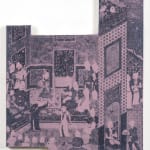-
Artworks
Kour Pour UK, b. 1987
Conversations in a Foreign Language, 2022Acrylic on canvas over panel29.3 x 23.5 x 2 in
74.3 x 59.7 x 5.1 cm8613Further images
The imagery in this shaped painting by Kour Pour is borrowed from the pages of the Shahnameh, an epic poem dating to 1010 CE, which recounts the myths, heroes, and...The imagery in this shaped painting by Kour Pour is borrowed from the pages of the Shahnameh, an epic poem dating to 1010 CE, which recounts the myths, heroes, and historic tales of the ancient Persian peoples. Since its first publication, the book has left an indelible impact on the evolution of the literature of all Persian speaking cultures. Kour Pour recalls fondly flipping through the book as a child and studying the images. His father was an Iranian refugee who worked two jobs in his adoptive home of England, and as such had little time to teach his children to read or speak Farsi. Even if he had had access to lessons, Pour recalls that there would have been few other Iranians to speak it with, and anyway to speak Farsi at that time in England would have made him a target of the overt racism commonly directed towards Iranian people. What he’s doing with these images is creating visual objects that simulate the experience he had with the Shahnameh growing up: objects that people can read visually and make up their own stories around. Each shaped painting in this series originates from an actual page in the epic poem. Pour eliminates the text, cuts out the remaining part of the page, builds a canvas in that shape, paints it a monochrome hue, and then screenprints the Persian miniature painting that illustrated the now-missing text. The result is a ghostly visual record of both presence and absence. Pour is mobilizing the visual presence of these paintings to reference the history of Modernism, which liberally borrowed from Islamic art, Persian art, and the art of other Eastern cultures. By reclaiming the history of shaped canvases, monochromes, and flat geometric abstract forms, he is continuing to foster the idea of intercultural aesthetic exchange, and challenging viewers to think about what is assimilated from one culture to another and how. It’s also important to note that the images Pour chooses to borrow from the book feature both inside and outside spaces—another way Pour is encouraging an examination of insiders and outsiders.2of 2













